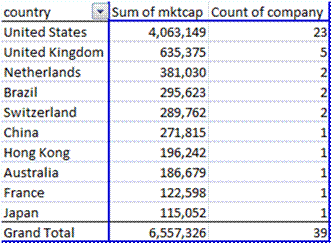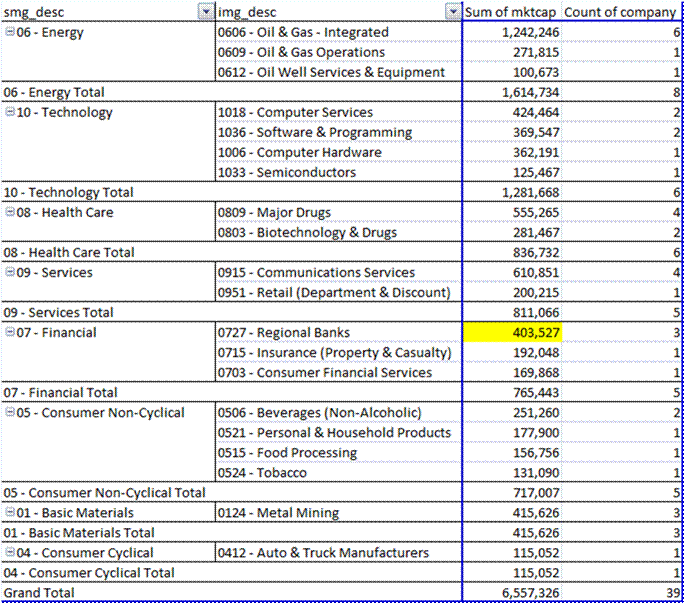A few things I left out last night. Here’s a country breakdown for Behemoths trading on US exchanges:
Note: if I had a Bloomberg terminal and could give you global data, this would look much less US-centric.
And, here is a sector and industry breakdown:
Going cell-by-cell, Oil & Gas – Integrated had the largest concentration. The companies were Exxon Mobil Corporation, Royal Dutch Shell plc (ADR), Chevron Corporation, Petroleo Brasileiro SA (ADR), BP plc (ADR), and TOTAL S.A. (ADR). Oil & Gas Operations was not all that different, and that company was PetroChina. These are simple companies, as I view them, mining all over the world to find energy for a hungry planet.
Then there is Schlumberger, in the Oil Well Services & Equipment industry. They are the elephant in their industry, though small compared to the majors, and smaller compared to the national oil companies that control most of the world’s oil resources.
Computer services are IBM and Google, two very different companies. Software & Programming is Microsoft and Oracle, also very different. Apple is Computers & Hardware. Intel is Semiconductors. The hard question with this group is who is managing their companies to use free cash flow wisely. This is a maturing industry, and the best companies in the future will treat their capital providers well.
In Healthcare the differences in industries is not worth considering. The companies are: Johnson & Johnson, Merck, Pfizer, Novartis AG (ADR), Roche Holding Ltd. (ADR), GlaxoSmithKline plc (ADR). They are all big pharmaceutical developers, though J&J has significant hardware businesses.
Communications Services boils down to China Mobile Ltd. (ADR), AT&T Inc., Vodafone Group Plc (ADR), Verizon Communications Inc. Big companies pursuing their advantages in the US, UK and China, with wireless dominating over wireline.
As for Retail, that is WalMart. Who else could it be? No other company in retail is so extensive. The hard question for them is how they move the needle. Are there no more worlds to conquer, a la Alexander?
Those that call regional banks are not so — JP Morgan and Wells Fargo are Money Center banks. HSBC (ADR) is as well.
Rounding out the financials are two nontraditional companies — Berkshire Hathaway, and General Electric. BRK is an insurance company funding an industrial conglomerate. GE is an industrial company with a finance arm attached to it.
Beverages (Non-Alcoholic) are simple. Coke and Pepsi. What could be simpler?
The other three in Consumer Non-Cyclical are Unilever N.V. (ADR), Procter & Gamble, and Philip Morris. It would be very difficult to reverse-engineer the competitive advantages that these companies have built up.
With Metals Mining it is BHP Billiton Limited (ADR), Vale (ADR), and Rio Tinto plc (ADR). They have become almost an oligopoly for a variety of minerals.
Finally, among auto and truck manufacturers, there is Toyota Motors, a well-run company that has had its share of problems lately.
Most of these companies are likely to be slow growers. One exception is some of the tech and pharmaceutical companies, where they will fight for new markets versus obsolescence of old markets. Unless one is an industry expert, hard to see how the battle comes out.
And, as I commented on last night’s piece:
Maynard, that’s a concern of mine as well. Will they dispose of noncore assets attractively? Even slack cash, after a suitable buffer, is noncore. How will management use the free cash flow?
1) Dividends?
2) Small value-creating acquisitions that can be grown organically?
3) Buybacks at discounts to the firm’s private market value?
Those create value, but it is hard to manage a complex company — so growing via acquisition is tough without overpaying by buying scale, or creating a company that is even more complex, and unmanageable.
That’s why I think management is the key with large companies — will they make the right capital allocation choices or not?
Tough analysis — but to me it boils down to how shareholder friendly behemoth companies will be. Try to analyze what the main strategies are, and only invest where you think they are managing for the good of shareholders, rather than management.
Full disclosure: my clients are long CVX, PBR, TOT, VOD, WMT, INTC, ORCL
- English (UK)
- English (India)
- English (Canada)
- English (Australia)
- English (South Africa)
- English (Philippines)
- English (Nigeria)
- Deutsch
- Español (España)
- Español (México)
- Français
- Italiano
- Nederlands
- Português (Portugal)
- Polski
- Português (Brasil)
- Русский
- Türkçe
- العربية
- Ελληνικά
- Svenska
- Suomi
- עברית
- 日本語
- 한국어
- 简体中文
- 繁體中文
- Bahasa Indonesia
- Bahasa Melayu
- ไทย
- Tiếng Việt
- हिंदी
Valuing Behemoths, Redux
Published 12/07/2011, 03:19 AM
Updated 07/09/2023, 06:31 AM
Valuing Behemoths, Redux
Latest comments
Loading next article…
Install Our App
Risk Disclosure: Trading in financial instruments and/or cryptocurrencies involves high risks including the risk of losing some, or all, of your investment amount, and may not be suitable for all investors. Prices of cryptocurrencies are extremely volatile and may be affected by external factors such as financial, regulatory or political events. Trading on margin increases the financial risks.
Before deciding to trade in financial instrument or cryptocurrencies you should be fully informed of the risks and costs associated with trading the financial markets, carefully consider your investment objectives, level of experience, and risk appetite, and seek professional advice where needed.
Fusion Media would like to remind you that the data contained in this website is not necessarily real-time nor accurate. The data and prices on the website are not necessarily provided by any market or exchange, but may be provided by market makers, and so prices may not be accurate and may differ from the actual price at any given market, meaning prices are indicative and not appropriate for trading purposes. Fusion Media and any provider of the data contained in this website will not accept liability for any loss or damage as a result of your trading, or your reliance on the information contained within this website.
It is prohibited to use, store, reproduce, display, modify, transmit or distribute the data contained in this website without the explicit prior written permission of Fusion Media and/or the data provider. All intellectual property rights are reserved by the providers and/or the exchange providing the data contained in this website.
Fusion Media may be compensated by the advertisers that appear on the website, based on your interaction with the advertisements or advertisers.
Before deciding to trade in financial instrument or cryptocurrencies you should be fully informed of the risks and costs associated with trading the financial markets, carefully consider your investment objectives, level of experience, and risk appetite, and seek professional advice where needed.
Fusion Media would like to remind you that the data contained in this website is not necessarily real-time nor accurate. The data and prices on the website are not necessarily provided by any market or exchange, but may be provided by market makers, and so prices may not be accurate and may differ from the actual price at any given market, meaning prices are indicative and not appropriate for trading purposes. Fusion Media and any provider of the data contained in this website will not accept liability for any loss or damage as a result of your trading, or your reliance on the information contained within this website.
It is prohibited to use, store, reproduce, display, modify, transmit or distribute the data contained in this website without the explicit prior written permission of Fusion Media and/or the data provider. All intellectual property rights are reserved by the providers and/or the exchange providing the data contained in this website.
Fusion Media may be compensated by the advertisers that appear on the website, based on your interaction with the advertisements or advertisers.
© 2007-2024 - Fusion Media Limited. All Rights Reserved.
